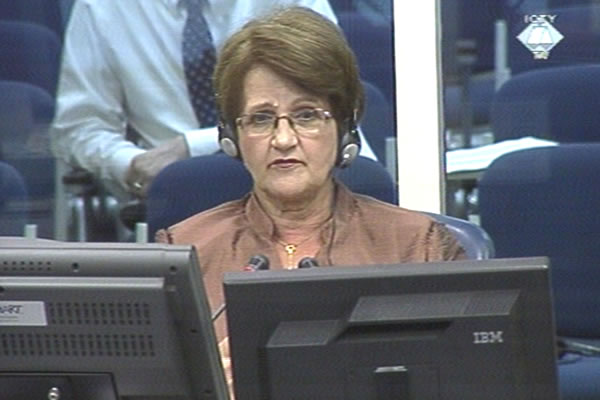Home
SREBRENICA SYNDROME
Psychotherapist Teufika Ibrahimefendic testified about the trauma and suffering of the survivors from Srebrenica at Ratko Mladic’s trial. Grief, deep pain and uncertainty because many of the victims have not been found and identified, and the resultant inability to go through the normal process of grieving for the lost family members, and the unclear circumstances in which they lost their lives are just a few of the features of the trauma experienced by the survivors. Dr Ibrahimefendic calls this trauma ‘the Srebrenica syndrome’
 Teufika Ibrahimefendic, witness at the Ratko Mladic trial
Teufika Ibrahimefendic, witness at the Ratko Mladic trial Psychotherapist from Tuzla Teufika Ibrahimefendic testified today at Ratko Mladic’s trial about the trauma experienced by the family members of the victims of the Srebrenica massacres in July 1995. Dr Ibrahimefendic has labeled their symptoms ‘the Srebrenica syndrome’: it is characterized by grief and deep pain because many of the victims have not been found and identified yet. As a result, the victims still live their lives in a state of uncertainty and confusion, 18 years on.
Dr Ibrahimefendic works as a therapist for the organization Viva-zene from Tuzla. The first time she testified about the trauma and suffering of the Srebrenica survivors in 2000 at the trial of General Radislav Krstic, who was sentenced to 35 years in prison for aiding and abetting the Srebrenica genocide. The transcript of her evidence at that trial was admitted into evidence at Ratko Mladic’s trial today. Mladic is also charged with the genocide in Srebrenica, that occurred after his troops overran the town on 11 July 1995.
The inability to bury the family members who were killed in 1995 keeps the survivors from Srebrenica ‘frozen in the past’, as the witness said. They are unable to face their loss and start grieving for them. On the other hand, the relatives of the victims who have been found and identified still face the feelings of sadness and uncertainty regarding the circumstances in which their kin lost their lives: they worry whether they had been hungry, thirsty, afraid, and so on. They need information and the truth, and the support of the community where they live. They need understanding and recognition of their suffering in order to be able to regain the trust they have lost.
According to the witness, since 2003, when the first identified victims from Srebrenica were buried, the psychological status of the survivors has been going up and down. They are still able to laugh from time to time, ‘but everything is tinged by death in a way’. Happy events, such as the birth of a grandchild, are always overshadowed by the events from the summer of 1995 and are filled with sadness because their nearest and dearest are not there to share the happiness with them. ‘I keep offering them life, and they offer me death in return’, Ibrahimefendic said.
As the witness said, the survivors from Srebrenica live their lives torn between the desire and resistance to return to Srebrenica; the latter is caused by the trauma they had been through there. In the cross-examination, Mladic’s lawyer Branko Lukic tried to attribute the trauma to the nostalgia felt by many of those who decided to leave their homes for economic reasons. The witness reminded him that the people did not leave Srebrenica ‘voluntarily’: they were forced to go.
After Dr Ibrahimefendic completed her evidence, the prosecution called Australian forensic pathologists Christopher Lawrence, who led the forensic team that conducted the post mortems of the victims exhumed from several mass graves in the Srebrenica area in 1998. Dr Lawrence and his team examined 2,239 body bags containing the remains of at least 883 Srebrenica men killed in the area. In most cases, death was caused by gunshot wounds. Shrapnel were found in some of the bodies. Dr Lawrence will continue his evidence tomorrow.
Linked Reports
- Case : Mladic
- 2013-07-16 BLINDFOLDS TELL A TALE
- 2013-07-15 EVIDENCE FROM MASS GRAVES
- 2013-07-10 AUSTRALIAN POLICE OFFICER IN SREBRENICA’S KILLING FIELDS
- 2013-07-19 BLINDFOLDS AND TIES FROM MASS GRAVES
- 2013-07-22 BULLET CASINGS FROM SREBRENICA EXECUTION SITES ANALYZED
- 2013-07-23 ‘OVERLAPPING’ IN COURTROOMS
